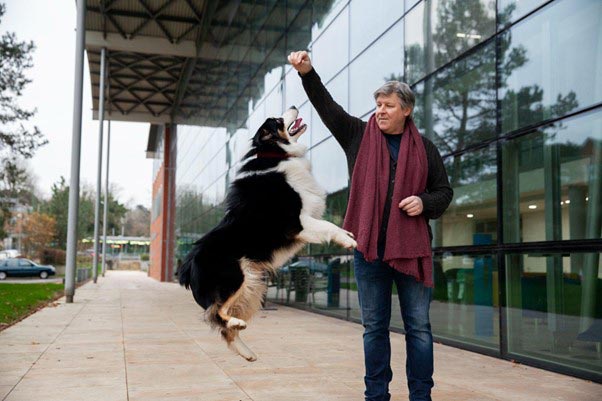Discover the Best Dog Training Method For Your Furry Friend
- Last updated on March 27, 2023
- By: Caroline Stowe
If you have ever found yourself trying to train a dog, you know that it can be quite a challenge.
Just like people, dogs learn in different ways. Some respond best to positive reinforcement while others need a more authoritative approach.
Every pup is different, and each one will respond differently to different methods of training.
But don’t worry! There are several types of dog training available, so there is sure to be something that works for your pet. Let’s explore the different types of methods.
Picking the Right Dog Training Method for Your Pet
Training a dog can be a daunting task and it often requires an understanding of different training methods.
Each type of method has its own advantages and disadvantages, so choosing the right one for your pup can be a bit overwhelming.
Let us help you understand the different types of dog training methods and pick the one that is best for your pet.
Bust first click the link below to learn about the basics of dog psychology used in training.
Positive Reinforcement Training (PRT)
This type of training focuses on rewarding desired behaviors with treats or praise rather than punishing bad behaviors. It encourages obedience by making it more rewarding to obey commands than to ignore them.
PRT works by establishing a clear link between an instruction and a reward—if the dog follows the command, they get something they enjoy in return.
This method is often seen as the most humane way to train a pet because it avoids punishing them for their mistakes.
Operant Conditioning
This type of training uses positive or negative reinforcement to shape behavior.
With this approach, owners reward dogs when they perform desired behaviors (positive reinforcement) or gently scold them when they perform undesired behaviors (negative reinforcement).
This type of training requires consistency from owners in order to be effective; otherwise, dogs may become confused about what is expected from them.
Additionally, operant conditioning should only be used by experienced trainers who understand how to use punishment correctly and humanely.
Clicker Training
Clicker training uses a clicker—a small handheld device that emits a clicking sound—to mark desired behaviors in order to reward them immediately.
This type of training works well for high-energy breeds because it provides an extra layer of structure and can keep their attention focused on learning through playtime activities instead of chasing after treats all day long.
Clicker training also helps create clear boundaries between acceptable and unacceptable behaviors by providing immediate feedback when either is exhibited by your pet.
However, this method does require patience as it takes time for pups to recognize the clicker sound as a reward signal—so don’t expect immediate results!
Additionally, some dogs may become desensitized to the clicker over time, making it less effective at reinforcing desired behaviors.
Obedience Training
Obedience training is another popular type of dog training that focuses on teaching specific commands such as sit, stay, come, and heel. The goal of obedience training is not only to teach the dog basic commands but also to establish communication between the owner and their pet.
Obedience classes are often run by professional trainers who specialize in helping owners train their dogs using techniques such as repetition and consistency.
If you want your pup to be well-behaved in public places or if you have specific commands that you want them to learn quickly, then obedience classes may be the best option for you.
Dominance-Based Training
This method of dog training focuses on teaching dogs how to be obedient through fear or intimidation rather than rewards or praise.
Dominance-based trainers believe that dogs should respect humans as “pack leaders” and must learn their place in the hierarchy through physical force or punishment if necessary.
Unfortunately, this type of approach has been largely discredited due to its potential for abuse and its lack of scientific evidence supporting its effectiveness.
Agility Training
Agility is an exciting sport where dogs race around an obstacle course made up of jumps, tunnels, weave poles, and other obstacles.
Agility courses are designed to test both the physical fitness and speed of a dog as well as their ability to obey commands from their handler while navigating the course at top speed.
Agility classes require both physical fitness and mental preparedness from both handler and canine; they are perfect for active dogs who need something challenging yet rewarding.
Classical Conditioning
Classical conditioning is a type of learning technique developed by Russian psychologist Ivan Pavlov in the early 1900s.
This method involves pairing a pleasant stimulus (like food or treats) with an action such as sitting or staying still.
The idea is that over time, your dog will associate the action with getting rewarded and will eventually do it without needing the reward.
This type of training can be useful if you want to teach your dog basic commands like “sit” and “stay.”
Trick Dogging/Tricks & Games
Trick Dogging/Tricks & Games is a type of dog training where you teach your dog fun tricks like rolling over, playing fetch, and more. It’s a great way to have fun with your pet and let them show off their skills!

Crate or Potty Training
Crate or potty training is a way to train dogs to go to the bathroom in the right place, like outside or in a special potty area.
You give them treats when they do it correctly. This helps them learn that going to the bathroom in the right spot is good behavior.
Socialization and Fear Reduction Techniques
Socialization and Fear Reduction Techniques of Dog Training are a way to teach dogs to not be scared or afraid of things. It helps them learn how to act around other animals and people.
With this type of training, you reward your dog with special treats or toys when they do something right. This type of training can help your dog feel more comfortable around new places, people, and animals.
Behavioral Modification
Behavioral Modification training teaches dogs to do certain things by changing their behavior.
This type of training works by rewarding good behaviors and ignoring bad ones, so the dog learns what is acceptable and what is not. It takes patience and consistency to be successful with this method of training.
Conclusion
With all these different types of dog training methods out there, how do you know which one is right for your pet? The answer depends on what kind of behavior you’re trying to modify or teach them.
Selecting the right type of dog training method depends on many factors including your pup’s age, breed, temperament, and overall health status.
It’s important to take into account all these factors before deciding on which method will work best for you and your pet.
For basic commands like sit and stay, classical conditioning can work well; however, if you want to teach more complex behaviors like agility courses or tricks, then clicker training may be better suited for your needs since it provides more precise feedback than other methods do.
Ultimately, it comes down to trial and error until you find the best fit for both you and your pup!
Our advice? Take some time to research each option carefully before making any commitments – after all, you want what’s best for both you and your four-legged friend!
-
Author: Caroline Stowe
- Updated on March 27, 2023
Disclaimer: This article doesn’t intend to replace professional veterinary advice, nor should it be used as a substitute for veterinary services, diagnosis, or treatment. The content on this website, including information and opinions expressed herein, are intended for general informational purposes only. In case you have concerns or questions regarding your dog’s health and diet requirements, please consult your veterinarian before doing anything that might affect it.
DogPetGuide.com and the writer are not responsible or liable for any damage, liability, costs, or claims arising from any possible consequences of the reader’s action after reading this article.




